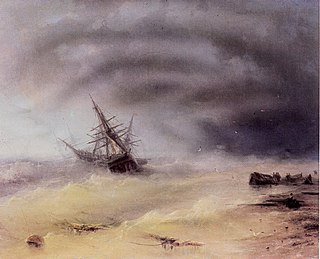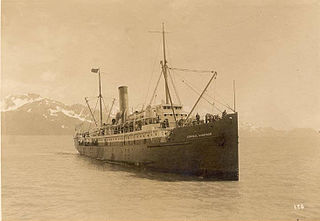Related Research Articles

1738 (MDCCXXXVIII) was a common year starting on Wednesday of the Gregorian calendar and a common year starting on Sunday of the Julian calendar, the 1738th year of the Common Era (CE) and Anno Domini (AD) designations, the 738th year of the 2nd millennium, the 38th year of the 18th century, and the 9th year of the 1730s decade. As of the start of 1738, the Gregorian calendar was 11 days ahead of the Julian calendar, which remained in localized use until 1923.

Whydah Gally was a fully rigged ship that was originally built as a passenger, cargo, and slave ship. On the return leg of her maiden voyage of the triangle trade, Whydah Gally was captured by the pirate Captain Samuel "Black Sam" Bellamy, beginning a new role in the Golden Age of Piracy.

Block Island is an island of the Outer Lands coastal archipelago, located approximately 9 miles (14 km) south of mainland Rhode Island and 14 miles (23 km) east of Long Island's Montauk Point. The island is coterminous with the town of New Shoreham, Rhode Island and is part of Washington County. The island is named after Dutch explorer Adriaen Block, and the town was named for Shoreham, Kent, in England.

Point Judith is a village and a small cape, on the coast of Narragansett, Rhode Island, on the western side of Narragansett Bay where it opens out onto Rhode Island Sound. It is the location for the year-round ferry service that connects Block Island to the mainland and contains the fishing hamlet of Galilee, Rhode Island.

A ghost ship, also known as a phantom ship, is a vessel with no living crew aboard; it may be a fictional ghostly vessel, such as the Flying Dutchman, or a physical derelict found adrift with its crew missing or dead, like the Mary Celeste. The term is sometimes used for ships that have been decommissioned but not yet scrapped, as well as drifting boats that have been found after breaking loose of their ropes and being carried away by the wind or the waves.

The Gaspee affair was a significant event in the lead-up to the American Revolution. HMS Gaspee was a Royal Navy revenue schooner that enforced the Navigation Acts around Newport, Rhode Island, in 1772. It ran aground in shallow water while chasing the packet boat Hannah on June 9 off of Warwick, Rhode Island. A group of men led by Abraham Whipple and John Brown I attacked, boarded, and burned the Gaspee to the waterline.

Sea Venture was a seventeenth-century English sailing ship, part of the Third Supply mission flotilla to the Jamestown Colony in 1609. She was the 300 ton flagship of the London Company. During the voyage to Virginia, Sea Venture encountered a tropical storm and was wrecked, with her crew and passengers landing on the uninhabited Bermuda. Sea Venture's wreck is widely thought to have been the inspiration for William Shakespeare's 1611 play The Tempest.

The Lexington was a paddlewheel steamboat operating along the Northeastern coast of the United States from 1835 to 1840. Commissioned by Cornelius Vanderbilt, it was one of the fastest and most luxurious steamers in operation.

William Henry "Bully" Hayes was a notorious American ship's captain who engaged in blackbirding in the 1860s and 1870s.

The Great Colonial Hurricane of 1635 was an extraordinarily powerful and devastating Atlantic hurricane that brushed Colonial Virginia and struck the New England Colonies in late August 1635. Accounts of the storm are very limited, but it was likely the most intense hurricane to hit New England since European colonization. The storm had a similar track and forward speed to that of the 1944 Great Atlantic hurricane and is the first of five known major hurricanes to have struck the modern New England region. The storm also likely produced one of the greatest storm surges in United States history, modern analysis has found.

Goat Island is a small island in Narragansett Bay and is part of the city of Newport, Rhode Island, U.S. The island is connected to the Easton's Point neighborhood via a causeway bridge. It is home to the Newport Harbor Light (1842), residences, a restaurant, event space, and hotel. It was also home to several military forts and to the U.S. Naval Torpedo Station, and was the site of the attacks on HMS St John and HMS Liberty.

SS Valencia was an iron-hulled passenger steamer built for the Red D Line for service between Venezuela and New York City. She was built in 1882 by William Cramp and Sons, one year after the construction of her sister ship Caracas. She was a 1,598-ton vessel, 252 feet (77 m) in length. In 1897, Valencia was deliberately attacked by the Spanish cruiser Reina Mercedes off Guantanamo Bay, Cuba. The next year, she became a coastal passenger liner on the U.S. West Coast and served periodically in the Spanish–American War as a troopship to the Philippines. Valencia was wrecked off Cape Beale, which is near Clo-oose, on the west coast of Vancouver Island, British Columbia, on 22 January 1906. As her sinking killed 100 people, some classify the wreck of Valencia as the worst maritime disaster in the "Graveyard of the Pacific", a famously treacherous area off the southwest coast of Vancouver Island.

The Lady Lovibond is the name given to a legendary schooner that is alleged to have been wrecked on the Goodwin Sands, off the Kent coast of south-east England, on 13 February 1748, and is said to reappear there every fifty years as a ghost ship. No contemporary records of the ship or its supposed sinking have been found.
Eliza was an American brig wrecked at Fiji in 1808. Eliza had been constructed and registered at Providence, Rhode Island, United States. She carried a crew of ten and was owned by Brown & Ives.

The siege of Fort Mifflin or the siege of Mud Island Fort, which took place from September 26 to November 16, 1777, saw British land batteries commanded by Captain John Montresor and a British naval squadron under Vice Admiral Lord Richard Howe attempt to capture an American fort in the Delaware River that was commanded by Lieutenant Colonel Samuel Smith. The operation finally succeeded after Smith was wounded. His successor, Major Simeon Thayer, subsequently evacuated the fort on the night of November 15, enabling British troops to occupy the place the following morning.
Simeon Thayer fought in Rogers' Rangers during the French and Indian War and made a harrowing escape from French-allied Indians. At the outbreak of the American Revolutionary War, the Rhode Island assembly appointed him an officer. He quickly raised a company of soldiers and marched with them to the Siege of Boston. He and his men went on Benedict Arnold's expedition to Quebec during which time he kept a journal of his experiences. He fought at Quebec and was captured. After being paroled, he again served as an officer in the Continental Army. Simeon Thayer was a member of the Society of the Cincinnati of the State of Rhode Island.

The SS Admiral Sampson was a U.S.-flagged cargo and passenger steamship that served three owners between 1898 and 1914, when it was rammed by a Canadian passenger liner and sank in Puget Sound. Following its sinking off Point No Point, the Admiral Sampson has become a notable scuba diving destination for advanced recreational divers certified to use rebreathing equipment.

Green Jacket Shoal is a 33-acre (13 ha) shoal and ship graveyard in Providence River, between the cities of East Providence and Providence, Rhode Island, United States. It contains a large amount of debris from a century of abandoned and wrecked ships, destroyed docks, pilings, and other remnants of the area's industrial past. India Point, on the Providence side, was the city's first port, which remained active from 1680 until the Great Depression in the early 20th century. Bold Point, on the East Providence side, was home to a dry dock and other maritime businesses.

Charles Eaton was a barque, launched in 1833 for use as a merchant ship. Whilst under the command of Captain Fowle, she was wrecked in 1834 among the Torres Strait Islands, off the northern coast of Queensland, Australia, and her passengers and crew attacked and nearly all killed by Torres Strait Islanders on Mer Island. A cabin boy and small child survived and lived with the islanders until being rescued by Captain Lewis and crew on Isabella in June 1836, who also found skulls of some of the murdered people on a nearby island and took them back to Sydney for burial.
SS Lexington was an American Passenger ship that collided with Jane Christenson and sank on 2 January 1935 on the East River in New York City while carrying general cargo and 201 passengers and crew from New York to Providence, Rhode Island.
References
- Goss, Michael; Behe, George (1994). Lost at Sea: Ghost Ships and Other Mysteries. Prometheus Books. ISBN 1615924663 . Retrieved June 18, 2013.
- Society of Colonial Wars in the State of Rhode Island and Providence Plantations (1939). Depositions of officers of the Palatine ship "Princess Augusta" Wrecked on Block Island, 27th December, 1738 and which was apparently the "Palatine" of Whittier's Poem . Retrieved May 25, 2015.